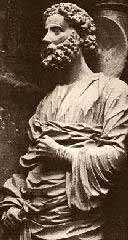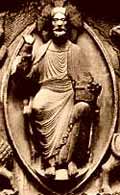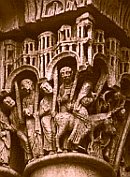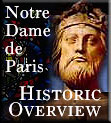

Expression and Technique of Craft
Utilized Within Gothic Churches,
Cathedrals & Monasteries :

Image at right : The choir screen at Ely Cathedral, England; profusely decorated with ball flowers.
The ball flower motif began to appear as decoration was more strongly emphasized during the thirteenth century being most widely employed within English structures.

Image at right : A portal jamb figure at Notre Dame de Rheims, France featuring the Damp fold technique.

Image at right : Detail of Madonna Enthroned with Child; fresco (1278-80) by Cimabue, Lower Church, San Francesco, Assisi.
 The space which represents the shape of a Mandorla is the overlapping segment of two intersecting circles.
The space which represents the shape of a Mandorla is the overlapping segment of two intersecting circles.Image at right : The figure of Christ within a Mandorla frame; Notre Dame de Chartres, France.
In Christian context, the place where Heaven and Earth join as one, perhaps even the doorway between the two. Many cathedral portals feature Christ or the Virgin enthroned within a Mandorla frame.
 Variations in execution include high relief where the primary figures are shown to, at least, half their full dimension; bas-relief, which projects only slightly from the background and incised relief, where the figures are carved below the level of the background.
Variations in execution include high relief where the primary figures are shown to, at least, half their full dimension; bas-relief, which projects only slightly from the background and incised relief, where the figures are carved below the level of the background.Image at right : Twelfth century French capital sculpted in high relief.
Incised or sunken relief produces the inverse of intaglio sculpting; a hollowed out negative representation.
 and would evenutally reach an artistic apex in fifteenth century France. The tapestry provided an ideal medium for illustrating religious allegory, tales from the Bible and lives of the saints.
and would evenutally reach an artistic apex in fifteenth century France. The tapestry provided an ideal medium for illustrating religious allegory, tales from the Bible and lives of the saints.Image at right : A unusual depiction of the Crucifixion, sharing regional pagan symbolism, within a Tapestry at Canterbury cathedral, England.
“The beautiful city of Viterbo twelve miles away, whence Toscanella can be reached most conveniently,
 has several early Romanesque churches. That of S, Sisto, with an apse that protrudes through the city wall, has capitals that break away from Roman example, and a strange clustered pillar spirally twisted.
The Cathedral, though much modernized, has preserved its ancient
Romanesque arcades, in which are capitals resembling Byzantine work, with eagles at the angles like those at Salonica, and quadruped sphinxes with a female head and a pair of wings.
has several early Romanesque churches. That of S, Sisto, with an apse that protrudes through the city wall, has capitals that break away from Roman example, and a strange clustered pillar spirally twisted.
The Cathedral, though much modernized, has preserved its ancient
Romanesque arcades, in which are capitals resembling Byzantine work, with eagles at the angles like those at Salonica, and quadruped sphinxes with a female head and a pair of wings.
In these buildings, and others that are coeval with them, in spite of the rudeness of their execution and the coarseness of their figure sculpture, one cannot fail to see the seed of future excellence. It seemed necessary that the decline which set in with Constantine should reach a bathos before it was arrested, and gave way to the stirrings of a new life.
Ancient tradition was dead or nearly so: technical skill was at the lowest possible ebb: for columns and capitals and such features as required dexterous workmanship, recourse was had to the spoils of ancient buildings: constructional problems were avoided, and the churches were mere walls with wooden roofs, vaults being beyond the builders' humble resources. But in the way these materials were put together, whether they were original or pilfered from old buildings, in the proportions adopted, and in the evident striving after beauty, we see that the artistic sense was alive, that it had in it all the promise of youth, and that it wanted nothing but practice, experience, and knowledge to develop a new and noble art.”
—Thomas Graham Jackson, R.A.,Byzantine and Romanesque Architecture, 1913
“St. Sebaldus is the next best thing to St. Laurentius. It is one of the finest churches in Germany, and contains perhaps greater art treasures than any other. It has the famous stone-work of Adam Krafft, and some stained glass by Veit Hirsvogel, done in 1515, representing the “Margrave Frederick of Anspach and Baireuth,” with his wife and eight children, the quaintest thing imaginable; an altar-piece, painted in 1513 by Hans von Kulmbach, with drawings by Dürer.
But the most exquisite gem of art in this church is an iron monument or casket holding the remains of St. Sebald, the masterpiece of Peter Vischer, the celebrated worker in bronze and iron. He and his five sons worked on it for thirteen years. O delicious and quiet age of the world, when the educated craftsman could go for thirteen years with his great work, letting it grow as the trees grow, silently, patiently, perfectly, to remain forever a study and a joy to those who love art and perfect expression, and who turn sighing away from the hasty, ill-conceived, ill-executed work of these modern and hurried times!”
—M. E. W. Sherwood,Nuremberg, 1871,
The Galaxy Magazine
“... whatever may be the meaning with which we use the term proportion, it is certainly not the same thing as beauty. It is not that secret power which awakens in the cultivated and sensitive mind a mysterious sense of enchantment, as if it were in the presence of some hidden power, which lived a life of its own beyond the reach of all the rules and regulations of art and the deductions of science. Beauty in architecture, then, is the result not only of the adoption of certain curves and straight lines, accompanied with a suggestion of structural strength and of practical adaptation to the purposes for which the building is raised, but upon the more or less frequent repetition of some unit of length, which seizes upon the eye of the spectator, and fills his mind with a sense of harmony of which he is none the less conscious because he cannot explain precisely what it is that he feels. Upon this skeleton or linear structure the designer proceeds to place a multitude of details, in themselves suggestive of fitness and utility, and in their combination pleasant and varied. Taken singly, the effect of these essentials will not amount to positive beauty, though there can be no beauty without them. For I use the word beauty in its strictest sense, as expressing the highest perfection which man's art can attain.”
—Rev. J. M. Capes, M.A.,Principles of Architectural Beauty, 1880

“The artist, whatever may be his gifts, must be a man of his time, in advance of it no doubt if a real artist, but still of it; human passions and emotions are the same in all ages, modified only by circumstances. The conditions of life in which the poet lives do not effect him. His creations are not presented to the reader by the outward characteristics, when expressing the thoughts of his age. The artist's eye from habit will become, so to speak, saturated with beauty or ugliness, he must be affected by reality; if the things he is for ever taking in are noble, nobility will be his natural artistic language and material, and vice versa. If he, not finding in his material life what he requires, is driven to invent, he will produce monstrosities, or reproduce what has been done before under favouring conditions and therefore spontaneously; but such reproductions will no longer be of any value, not being spontaneous products.”
—George Frederic Watts, Thoughts on Art“In France after the eleventh century the tendency to diminish the thickness of the column in proportion to that of its load became constant, and the development of the capital into a more and more spreading form necessarily followed. The degree of expansion given to the capital varied considerably according to circumstances. Where monolithic shafts of compact stone could be obtained, it was found that these might be made very slender, and yet be strong enough to bear all the weight that could be gathered upon a widely spreading abacus. The frank carrying out of this principle led to the production of the distinctly Gothic type of capital.”
—Charles Herbert Moore, Development and Character of Gothic Architecture, 1890Bibliography
Matthew Holbeche Bloxam, London, D. Bogue (1846)
Eugène Viollet-le-Duc, Paris (1858-68)
Charles Herbert Moore, New York (1890)
Émile Mâle, London (1913)
Development & Production Credits
Primary Text : Rhey Cedron — Theme Editor : Nicole MarchStructural Design & Project Direction : Rhey Cedron
Art Direction : Thierry Alberto — Art Production : Mark Nelson & Ash' Murti
Principal Photography : Rhey Cedron
Art Research : Malcolm Hurrell — Support Research : Walter McCrae
(Life) Support Production : Henry Craig, Joan Flandrin, Clara Kelly and
a Patient Legion of Friends, Family & Angels
cultural projects. Ask to receive your free newsletter
Your questions or comments are always welcome!
Gothic Dreams E-mail
Individual use of enclosed material is encouraged for the purposes of education and enjoyment.
The republication of textual or graphic content, without license, is an infringement of Copyright laws.

